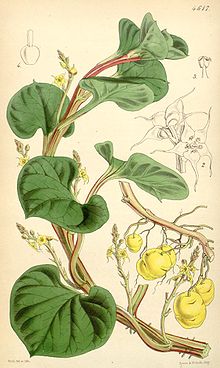Melloco
| Ulluco | |
|---|---|
 |
|
| Scientific classification | |
| Kingdom: | Plantae |
| (unranked): | Angiosperms |
| (unranked): | Eudicots |
| (unranked): | Core eudicots |
| Order: | Caryophyllales |
| Family: | Basellaceae |
| Genus: |
Ullucus Caldas |
| Species: | U. tuberosus |
| Binomial name | |
|
Ullucus tuberosus Caldas |
|
| Nutritional value per 100 g (3.5 oz) | |
|---|---|
| Energy | 74.4 kcal (311 kJ) |
|
15.3 g
|
|
| Dietary fiber | 0.9 g |
|
0.1 g
|
|
|
2.6 g
|
|
|
|
| Percentages are roughly approximated using US recommendations for adults. Source: Cultivariable |
|
Ullucus is a genus of flowering plants in the family Basellaceae, with one species, Ullucus tuberosus (Quechua ulluku (u:ju:ku), hispanicized spellings olluco, ulluco, or milluku, hispanicized melloco) a plant grown primarily as a root vegetable, secondarily as a leaf vegetable. Another common name in Spanish is papalisa.
Ulluco is one of the most widely grown and economically important root crops in the Andean region of South America, second only to the potato. It is known there with the common name of papalisa, but also by the regional names milluku and ulluku (Bolivia, Ecuador, Peru), chugua and uyucos (Colombia) or ruba (Venezuela), among others. The tuber is the primary edible part, but the leaf is also used and is similar to spinach. They are known to contain high levels of protein, calcium, and carotene. Ulluco was used by the Incas prior to arrival of Europeans in South America.
Ullucus tuberosus has a subspecies, Ullucus tuberosus subsp. aborigineus, which is considered a wild type. While the domesticated varieties are generally erect and have a diploid genome, the subspecies is generally a trailing vine and has a triploid genome.
The major appeal of ulluco is its crisp texture which, like the jicama, remains even when cooked. Because of its high water content, ulluco is not suitable for frying or baking, but it can be cooked in many other ways like the potato. In the pickled form, it is added to hot sauces. It is the main ingredient in the classic Peruvian dish olluquito con ch'arki, and a basic ingredient together with the mashua in the typical Colombian dish cocido boyacense. They are generally cut into thin strips.
...
Wikipedia
